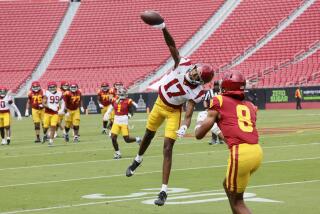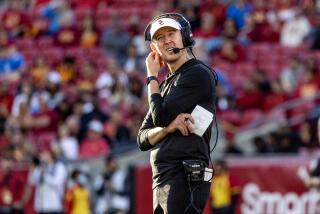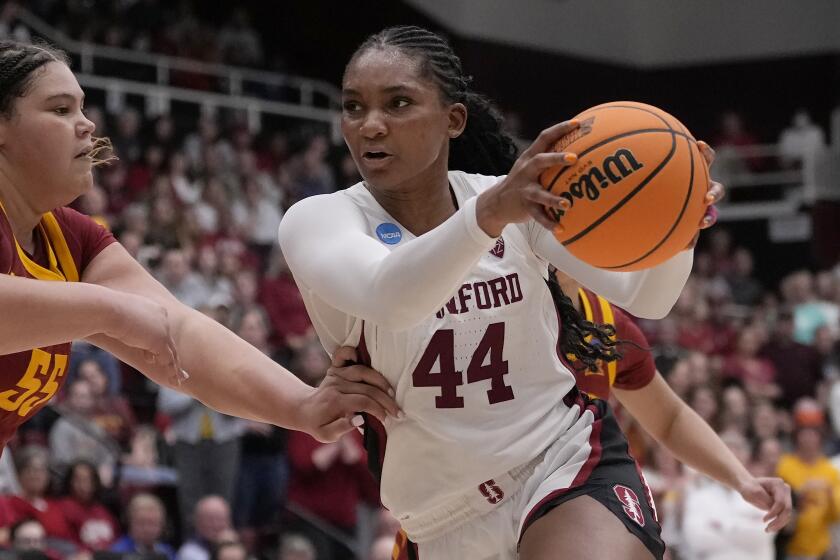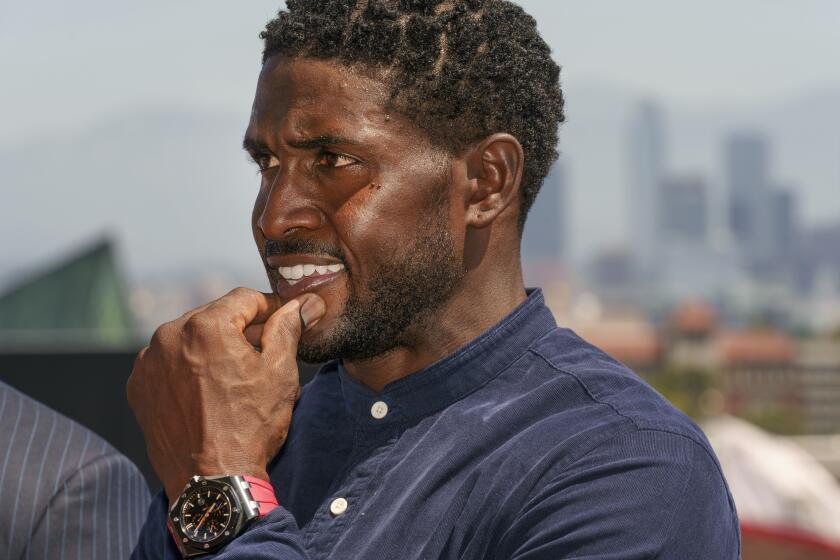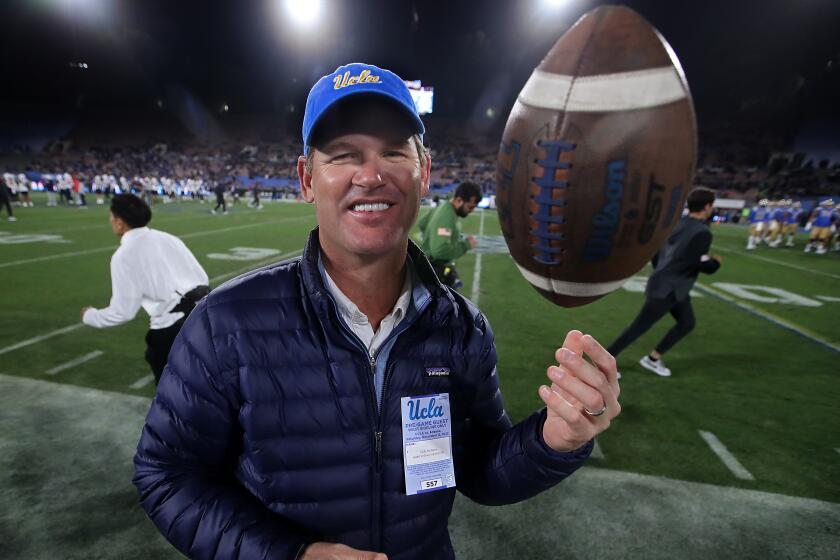USC’s Steve Sarkisian hopes fans can embrace break with tradition

It’s game day at the Coliseum. How will the Trojans respond after a week of distractions?
There is a certain traditional look to USC football.
Traveler, the white horse, races down the sidelines during home games, right past the iconic USC song girls. The Trojans marching band performs “Fight On” after every USC first down. And fans need a program to identify the Trojans because they are the only players in major college football who have never had names on the back of their jerseys.
But change will be obvious the first time USC has the ball Saturday when the Trojans open the season against Fresno State at the Coliseum.
New Coach Steve Sarkisian has hit the fast-forward button on USC’s offense.
Get ready for no huddles. For a quarterback mainly in the shotgun formation. Coaches relaying signs to players like baseball third-base coaches. Sideline staff holding giant cards featuring NFL team helmets, colors and various patterns and symbols.
The frenetic pace will surprise — and possibly irk — some longtime fans.
Sarkisian is not concerned. He is confident the offense will produce points and victories while engaging fans.
“I would caution you to be careful when you get up to get your popcorn, your soda,” Sarkisian told USC boosters last week. “Because we go fast.”
—
Music blares from speakers at the campus practice facility as the coach moves quickly across the field.
It’s early August and Sarkisian, dressed in a black athletic shirt, black shorts and a black USC cap, implores Trojans quarterbacks and running backs to pick up the pace.
“Faster, faster, faster!” he yells as they run play after play.
Later, watching the workout again on video, Sarkisian employs a stopwatch to record seconds elapsed from the end of a play to the next snap. If it’s more than 13 seconds, that’s too slow.
College football rules allow 40 seconds between plays and, for decades, teams used nearly every one.
During the late 1960s and into the early 1980s, USC teams coached by John McKay and John Robinson pounded most opponents into submission. Tailbacks O.J. Simpson, Charles White and Marcus Allen won Heisman Trophies running out of the I-formation as the Trojans won national titles and Rose Bowls.
Two decades of mostly middling success followed, until the program was reborn under coach Pete Carroll. Quarterbacks Carson Palmer and Matt Leinart and running back Reggie Bush won Heismans in a pro-style system and the Trojans won two Associated Press national titles.
But the Carroll era came with a steep cost. An NCAA investigation centered on Bush resulted in four years of probation and scholarship reductions.
Former athletic director Mike Garrett hired Kiffin after Carroll left to coach the NFL’s Seattle Seahawks. Kiffin lasted 3 1/2 seasons before he was fired last year, many USC fans thrilled to see his laminated, menu-sized play-call sheet gone from the sideline.
Sarkisian was not an all-popular replacement. He was another former Carroll assistant who never won more than eight games in five seasons as coach at Washington.
“I don’t expect everyone to say, ‘This is the greatest thing since sliced bread,’” Sarkisian says of an offense he adopted last season.
But he is certain it will be effective.
The Trojans, quarterback Cody Kessler says, are “having a blast” running the attack.
And, he adds, “People are going to have a blast watching it.”
—
Sarkisian, 40, didn’t always favor frenzied football.
He played quarterback in fairly traditional systems at West Torrance High, El Camino College and Brigham Young University before playing a few seasons in the Canadian Football League. He and Kiffin worked for Carroll and ran a traditional pro-style system during the Trojans’ run to glory in the 2000s.
The change came while he was coach at Washington.
His first team in 2009 featured quarterback Jake Locker, whose mobility demanded an outlet from the traditional confines of taking a snap from directly behind the center. A few years later, Sarkisian noticed that his injury-plagued 2012 team performed better in situations when it did not huddle. He watched and studied nearly every bowl game that postseason, scribbling notes about teams that pushed the pace.
“The rules tell you that you should,” he says of running a no-huddle offense. “There’s nothing telling you to slow down.”
Kiffin utilized long, verbal play calls that required quarterbacks to reference a wristband in the huddle.
Sarkisian, citing short attention spans and a generation of players comfortably navigating multiple touch screens, eliminated verbiage in favor of visual cues. The cards on the sideline are sometimes in play and other times used as decoys. Play calls are no more than four words.
“We’re trying to play in a world in which they already operate on a daily basis,” he says of his players, adding, “that world of what they’re comfortable in.”
—
USC claims 11 national championships and has won 24 Rose Bowl games.
Coaches such as Elmer Henderson, Howard Jones, McKay, Robinson and Carroll led the Trojans to glory. But fans did not cheer their every move.
“Those purists used to write me letters bitching about how boring we were,” Robinson says, laughing. “‘Why don’t you guys open it up and throw the ball like Bill Walsh does at Stanford?’”
Pat Haden played quarterback for USC in the early 1970s under McKay. After becoming USC’s athletic director in 2010, he watched Sarkisian take a winless Washington program to respectability.
Haden says he has no reservations about Sarkisian’s offense. Fans bent on tradition, he says, will enjoy the pace.
“You may not be able to take as many bathroom breaks because there are more plays,” Haden says. “But it’s still power football.”
Opposing coaches expect the Trojans will be successful regardless of how traditionalists initially accept the new style.
“Some of those guys might kind of hiccup a little bit during the course of the game,” Stanford Coach Davis Shaw says. “But the bottom line is Steve Sarkisian knows what he’s doing.”
Oregon State Coach Mike Riley worked as a USC assistant under Robinson in the mid-90s.
Riley, twice pursued by USC to become head coach, said he “loves the tradition at USC, but you’ve got to be careful,” because fans can be wary of embracing change.
“If you win and it’s productive, people won’t have much to say about it,” he says. “If it’s not … then it will be that deal, ‘Well, that’s not USC football.’”
—
Tim Curry, an emeritus sociology professor at Ohio State University, studies the sociology of sport, with an expertise in emotions and ritual. Wary USC fans will embrace change, he says, if Sarkisian’s new scheme is functional.
“If the ‘SC offense is explosive and scores quickly and often, the fans will say, ‘OK, you can win games that way,’” Curry says.
Longtime college football announcer Keith Jackson has watched the Trojans for decades.
“There will be some old boys my age who will grumble a little bit,” says Jackson, 85.
But Trojans touchdowns — lots of them — will keep the fans happy.
“If they give that white horse a reason to run,” Jackson says, “that might be the most important thing.”
Haden is optimistic. He says Sarkisian so far aced the “easy things.” He charms fans and donors and communicates well with the media.
Now, the season is about to begin.
“I don’t think I’ll get too many calls complaining that we’re running too many plays,” Haden says.
But Sarkisian knows naysayers can be convinced only one way.
“You get everybody,” he says, “by winning a bunch of games.”
More to Read
Go beyond the scoreboard
Get the latest on L.A.'s teams in the daily Sports Report newsletter.
You may occasionally receive promotional content from the Los Angeles Times.

